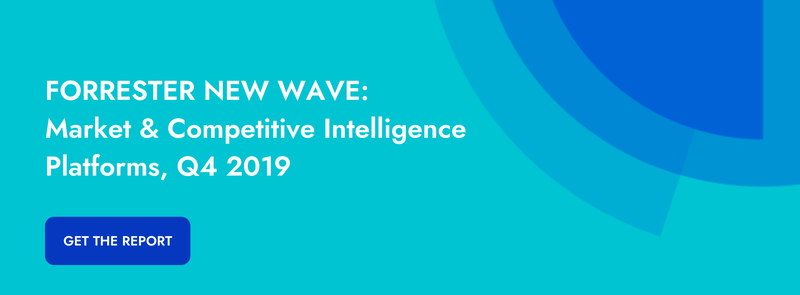June is here and with it comes a brand new episode of Into the Fray: The Competitive Intelligence Podcast!
In our latest installment, podcast host, Erik Mansur (our VP of Product Marketing), sat down with Penny Moran, the Head of Competitive Intelligence at Zuora. Throughout Penny’s career she has improved the competitive posture for countless sales teams, consulted with executive leadership on making sound decisions for the future of companies, and she’s had a big impact on broader business strategy for nearly every one of the logos on her CV — including companies like Intuit and Texas Instruments.
But today, Penny and I didn’t talk as much about competitive intelligence. Instead, I brought Penny on to dive deep on another critical offshoot of that role — one that many product marketers have realized is going to be a part of their job soon, if it isn’t already — and that role is: analyzing your company's win/loss and competitive success.
Win/loss projects or programs can be a driver of meaningful change. But while win loss analysis is pretty closely related to CI, I was curious to hear from Penny how it started for her. Where did her relationships with win/loss begin? Was it always a part of her CI process?
Today’s blog post will provide a snapshot of my discussion with Penny. What are you waiting for? Let’s dive into some key takeaways from our conversation!
ELEVATE YOUR PRODUCT MARKETING STRATEGY WITH THIS FREE KIT
From Project to Program: Creating a Win/Loss Process That’s Repeatable and Actionable | Penny Moran, Head of Competitive Intelligence at Zuora
Win/loss analysis has long been an essential practice for any company intent on developing a comprehensive understanding of their competitive landscape. It is the process of determining precisely why deals are won or lost by evaluating performance against variables such as industry, company size, and competitor involvement. But despite the proven value of win/loss analysis, not everyone is eager to jump aboard the win/loss train.
Penny and Erik discussed the origins of a healthy and sustainable win/loss program. And yes, you read that correctly — win/loss program, not win/loss project. According to Penny, successful win/loss analysis isn’t a one-time thing. Instead, it must be an ongoing process that evolves every quarter.
“I like to use the word program. To me, a project is a one-time thing that you go work on and then you’re done. This is not done. Win/loss is an ongoing program that is built to bring in insights quarterly.”
So, once you decide that it’s time to implement a win/loss program at your company, where do you start? Penny and Erik dove into not only what it takes to launch a thriving win/loss program from the very beginning, but also the signs to look out for that signal the success of your program once it is underway.
The first step is generating stakeholder buy-in. When introducing a win/loss program to your company, there can be hesitancy on the part of the leadership team and the sellers themselves — especially if they view win/loss through a negative lens or interpret it as a means of spying on their performance. It can take some time to build up the level of confidence your company has in your win/loss program, but once you prove the value to sellers they become quick to hop on board.
In business, we talk about this notion of maturity — how much expertise a person or department has at doing a certain task. When Erik asked Penny to define a mature win/loss program, she explained that there are three primary factors that make up a mature program: it is repeatable, it is external, and it is holistic.
From there, Penny led Erik through the best practices any win/loss program should abide by, as well as the steps it takes to implement a sustainable win/loss program — whether you are doing so for the first, second, or tenth time.
And that was only the surface of their conversation. For a closer look at a mature win/loss program and more invaluable insights on how to implement a state of art win/loss at your company, tune in to the full episode above or right here!
How to Succeed With Win Loss Analysis
If you want an overview of creating a win/loss program at your company, this episode is a great starting point for you. But, if you’re looking to go a step further and begin activating the win/loss insights you’ve gathered, download How to Succeed with Win Loss Analysis — our comprehensive guide to getting enthusiastic buy-in from your key stakeholders, creating a win/loss project brief that sets you up for success, and much more.
Regardless of the state of your win/loss program, it’s time to get off the sidelines. In the words of Penny Moran, the right time to start putting a win/loss program together is now!
.jpg)
Seeing is believing! Check out Crayon for yourself.
Take a Product TourRelated Blog Posts
Popular Posts
-
 The 8 Free Market Research Tools and Resources You Need to Know
The 8 Free Market Research Tools and Resources You Need to Know
-
 6 Competitive Advantage Examples From the Real World
6 Competitive Advantage Examples From the Real World
-
 How to Create a Competitive Matrix (Step-by-Step Guide With Examples + Free Templates)
How to Create a Competitive Matrix (Step-by-Step Guide With Examples + Free Templates)
-
 24 Questions to Consider for Your Next SWOT Analysis
24 Questions to Consider for Your Next SWOT Analysis
-
 How to Measure Product Launch Success: 12 KPIs You Should Be Tracking
How to Measure Product Launch Success: 12 KPIs You Should Be Tracking


